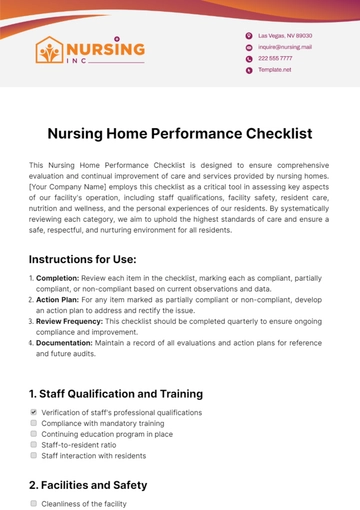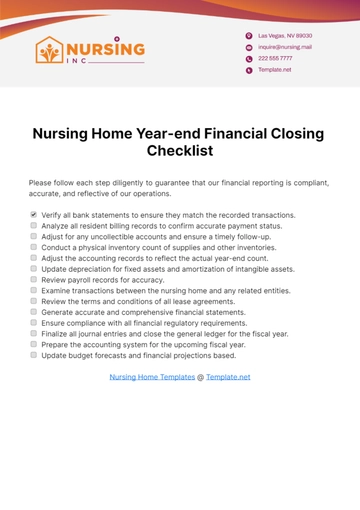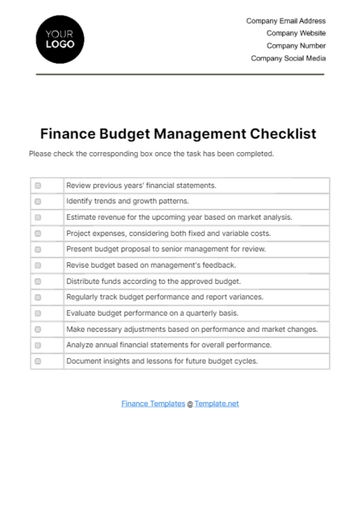Free Nursing Home Safety Inspection Checklist

This Nursing Home Safety Inspection Checklist assesses various safety aspects within [Your Company Name]. It helps ensure that the environment is safe for residents, staff, and visitors.
Building Safety:
Check for structural integrity, including walls, floors, and ceilings.
Inspect for any signs of water damage, leaks, or mold.
Ensure proper lighting in all areas, including hallways, rooms, and common areas.
Verify that emergency exits are clearly marked and unobstructed.
Fire Safety:
Test smoke detectors and fire alarms to ensure they are working properly.
Check fire extinguishers for expiration dates and proper placement.
Review evacuation plans with staff and ensure they are clearly posted.
Electrical Safety:
Inspect electrical outlets and appliances for any signs of damage.
Ensure that electrical cords are not frayed or creating tripping hazards.
Check that all electrical systems are up to code and properly maintained.
Medical Equipment Safety:
Verify that medical equipment such as wheelchairs, beds, and lifts are in good working condition.
Ensure that equipment is properly sanitized and stored when not in use.
Check expiration dates on medical supplies and medications.
Fall Prevention:
Assess the layout of the facility to minimize fall risks, such as removing clutter and securing rugs.
Ensure that handrails are installed in hallways and bathrooms.
Review resident care plans to identify individuals at risk for falls and implement appropriate interventions.
Infection Control:
Evaluate cleanliness and sanitation practices throughout the facility.
Ensure that staff members are following proper hand hygiene protocols.
Review procedures for handling and disposing of infectious waste.
Security:
Assess security measures such as access control systems and surveillance cameras.
Verify that all exterior doors are secured, and visitor policies are enforced.
Review procedures for responding to security incidents or emergencies.
Staff Training:
Ensure that staff members are trained in emergency procedures and know how to respond to various safety threats.
Verify that all staff members are up to date on required certifications and training.
Resident Safety:
Evaluate the overall well-being of residents, including their mobility, nutrition, and personal care needs.
Address any concerns regarding resident safety and comfort with the appropriate staff members.
Documentation:
Ensure that all safety inspections and maintenance activities are properly documented.
Keep records of any safety-related incidents or accidents and the actions taken to address them.
Note: This checklist should be regularly reviewed and updated to address any emerging safety concerns and ensure ongoing compliance with regulations and best practices in nursing home care.
- 100% Customizable, free editor
- Access 1 Million+ Templates, photo’s & graphics
- Download or share as a template
- Click and replace photos, graphics, text, backgrounds
- Resize, crop, AI write & more
- Access advanced editor
Ensure safety compliance in nursing homes with Template.net's Nursing Home Safety Inspection Checklist Template. Editable in our AI Editor Tool, this customizable template provides a structured format for conducting safety inspections, including checks for fire safety, emergency exits, electrical hazards, equipment maintenance, and infection control measures. Enhance safety protocols, mitigate risks, and maintain regulatory compliance!
You may also like
- Cleaning Checklist
- Daily Checklist
- Travel Checklist
- Self Care Checklist
- Risk Assessment Checklist
- Onboarding Checklist
- Quality Checklist
- Compliance Checklist
- Audit Checklist
- Registry Checklist
- HR Checklist
- Restaurant Checklist
- Checklist Layout
- Creative Checklist
- Sales Checklist
- Construction Checklist
- Task Checklist
- Professional Checklist
- Hotel Checklist
- Employee Checklist
- Moving Checklist
- Marketing Checklist
- Accounting Checklist
- Camping Checklist
- Packing Checklist
- Real Estate Checklist
- Cleaning Checklist Service
- New Employee Checklist
- Food Checklist
- Home Inspection Checklist
- Advertising Checklist
- Event Checklist
- SEO Checklist
- Assessment Checklist
- Inspection Checklist
- Baby Registry Checklist
- Induction Checklist
- Employee Training Checklist
- Medical Checklist
- Safety Checklist
- Site Checklist
- Job Checklist
- Service Checklist
- Nanny Checklist
- Building Checklist
- Work Checklist
- Office Checklist
- Training Checklist
- Website Checklist
- IT and Software Checklist
- Performance Checklist
- Project Checklist
- Startup Checklist
- Education Checklist
- Home Checklist
- School Checklist
- Maintenance Checklist
- Planning Checklist
- Manager Checklist
- Wedding Checklist
- Vehicle Checklist
- Travel Agency Checklist
- Vehicle Inspection Checklist
- Interior Design Checklist
- Backpacking Checklist
- Business Checklist
- Legal Checklist
- Nursing Home Checklist
- Weekly Checklist
- Recruitment Checklist
- Salon Checklist
- Baby Checklist
- Equipment Checklist
- Trade Show Checklist
- Party Checklist
- Hospital Bag Checklist
- Evaluation Checklist
- Agency Checklist
- First Apartment Checklist
- Hiring Checklist
- Opening Checklist
- Small Business Checklist
- Rental Checklist
- College Dorm Checklist
- New Puppy Checklist
- University Checklist
- Building Maintenance Checklist
- Work From Home Checklist
- Student Checklist
- Application Checklist





























